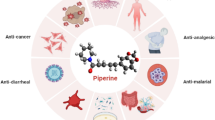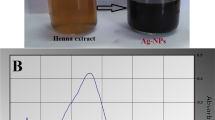Abstract
The efficacy of γ-rays is known as a method for decontamination of food, herbs and spices. In the present study, clove buds (CB) were irradiated at 10 kGy by 60Co irradiator. Essential oils (EOs) recovered from un-irradiated CB and irradiated (ICB) were evaluated for their chemical composition by GC–MS, antioxidant, antibiofilm and antibacterial activity. The minimum inhibitory concentration (MIC) and growth curves against four tested multi-drug resistant (MDR) bacterial pathogens; S. aureus, B. cereus, E. coli and K. pneumoniae were also evaluated. The liberation of cellular contents, as well as the alterations in cell membrane permeability, together with ultrastructural changes in the pathogen morphology, have been evaluated utilizing spectrophotometer, scanning electron microscope (SEM) and energy dispersive X-ray fluorescence spectrometry (EDXFS). Results revealed that EOs recovered from ICB leads to a rise in the phenolic and flavonoid contents by 3.82 and 3.44 mg/g of oil, respectively. Antioxidant potency was elevated by 6.63% for ICB recovered EOs compared to EOs from CB. Antibiofilm and antibacterial activities were improved against all tested MDR pathogens accompanied by decline in their cell growth. The MIC of EOs recovered from ICB raised up the release of bacterial intracellular proteins and DNA/RNA contents significantly (p < 0.05) in time dependent manner. The leakage of bacterial contents had been supported by the increase in the release of C, O, N, P, Mg with presence of new elements (Ca and S) in S. aureus treated with MIC of EOs recovered from ICB. Moreover, cell wall/membrane damages and shrinkage in S. aureus cells was clearly observed in SEM images. This study concluded that γ-rays at dose 10 kGy has a significant potential to stimulate antioxidant, antibiofilm and antibacterial potency of EOs recovered from CB due to increase in phenolic and flavonoid contents. This could improve the uses of EOs recovered from ICB will support the efforts to find a natural and more potent antioxidant, antibiofilm, and antibacterial against MDR pathogens, which is useful in food and pharmaceutical industries.






Similar content being viewed by others
References
A.B. Dehsheikh, M.M. Sourestani, P.B. Dehsheikh, J. Mottaghipisheh, S. Vitalini, M. Iriti, Mini Rev. Med. Chem. 20, 958–974 (2020). https://doi.org/10.2174/1389557520666200122144703
B.S. Jugreet, S. Suroowan, R.R.K. Rengasamy, M.F. Mahomoodally, Trends Food Sci. Technol. 101, 89–105 (2020). https://doi.org/10.1016/j.tifs.2020.04.025
D.H. Abou Baker, M. Al-Moghazy, A.A. ElSayed, Bioorg. Chem. 95, 103559 (2020). https://doi.org/10.1016/j.bioorg.2019.103559
Y. El Ghallab, A. Al Jahid, J.J. Eddine, A.A. Said, L. Zarayby, S. Derfoufi, Orient. Pharm. Exp. Med. 20(2), 153–158 (2020)
S. Amariei, S. Ciornei, E. Sanduleac, Stefan Cel Mare Univ. Suceava Romania (XII) 2, 143–147 (2013)
World Food Programme, Fumigation. [Online]. Available: http://foodqualityandsafety.wfp.org/fumigation 25 July (2017)
J.L. Daft, Sci. Total Environ. 100, 501–518 (1991). https://doi.org/10.1016/0048-9697(91)90390-Z
H. Ahari, M. Alineja Dizaj, S. Paidari, A.A. Anvar, Iran. J. Aquat. Anim. Health 2(2), 88–96 (2016). https://doi.org/10.18869/acadpub.ijaah.2.2.88
E. Groth, Available https://organic-center.org/reportfiles/IrradiationReport.pdf (2017)
E. Araby, H.G. Nada, S.A. Aboul El-Nour, A. Hammad, BMC Microbiol. 20, 186 (2020). https://doi.org/10.1186/s12866-020-01868-7
E.M. Gaspar, J.C. Santana, P.M. Santos, J.P. Telo, A.J. Vieira, J. Sci. Food Agric. 99, 1668–1674 (2019). https://doi.org/10.1002/jsfa.9351
British Pharmacopoeia Commission L (United K eng. British Pharmacopoeia, 1993). https://agris.fao.org/agris-search/search.do?recordID=XF2015028047. Accessed 2 Apr 2021.
B.P. Ezhilan, R. Neelamegam, Pharmacog. Res. 4, 11–14 (2012). https://doi.org/10.4103/0974-8490.91028
V.L. Singleton, J.A. Rossi, Am. J. Enol. Vitic. 16, 144–158 (1965)
D. Marinova, F. Ribarova, M. Atanassova, J. Univ. Chem. Technol. Met. 40(3), 255–260 (2005)
S. Salmanian, A.R. Sadeghi Mahoonak, M. Alami, M. Ghorbani, J. Agric. Sci. Technol. 16, 343–354 (2014)
C.L.S.I. Clinical and Laboratory Standards Institute. 7th informal supplement. CLSI document M100S. (2017)
S.Y. El-Tablawy, E. Araby, IOSR J. Pharm. Biol. Sci. 12, 63–71 (2017). https://doi.org/10.9790/3008-1203016371
A. Barapatre, K.R. Aadil, H. Jha, Bioresour. Bioprocess. 3, 8–20 (2016). https://doi.org/10.1186/s40643-016-0083-y
M.M. Bradford, Anal. Biochem. 72, 248–254 (1976)
C.F. Carson, B.J. Mee, T.V. Riley, Antimicrob. Agents Chemother. 46, 1914–1920 (2002). https://doi.org/10.1128/AAC.46.6.1914-1920
K. McKenzie, M. Maclean, M.H. Grant, P. Ramakrishnan, S.J. MacGregor, J.G. Anderson, Microbiol (United Kingdom) 162, 1680–1688 (2016). https://doi.org/10.1099/mic.0.000350
V.K. Bajpai, S.M. Al-Reza, U.K. Choi, J.H. Lee, S.C. Kang, Food Chem. Toxicol. 47, 1876–1883 (2009). https://doi.org/10.1016/j.fct.2009.04.043
B. Sazesh, M. Goli, J. Food Process Preserv. 44(8), e14563 (2020). https://doi.org/10.1590/fst.60820
F. Jalalizand, M. Goli, J. Food Meas. Charact. 15(1), 495–507 (2021). https://doi.org/10.1007/s11694-020-00659-y
W.H.O. World Health Organization, Google Books (WHO, Geneva, 1999)
A.G. Chmielewski, W. Migda, Nukleonika 50, 179–184 (2005)
A.A. Aly, R.W. Maraei, H.G.M. Ali, JAOCS J. Am. Oil Chem. Soc. 93, 397–404 (2016). https://doi.org/10.1007/s11746-015-2781-6
A.H. Alshawi, Food Technol. 10(9) Ver. III, 01–07 (2016). https://doi.org/10.9790/2402-1009030107
H.S. EL-Beltagi, F. Dhawi, A.A. Aly, A.E. EL-Ansary, Not. Bot. Horti. Agrobot. Cluj-Napoca 48, 2114–2133 (2020). https://doi.org/10.15835/nbha48412115
M. Suhaj, J. Horváthová, J. Food Nutr. Res. 46, 112–122 (2007)
M.M. Akbar Boojar, Adv. Pharm. Bull. 10, 13–9 (2020). https://doi.org/10.15171/apb.2020.002
M.S. Daneshzadeh, H. Abbaspour, L. Amjad, A.M. Nafchi, J. Food Meas. Charact. 14(2), 708–715 (2020). https://doi.org/10.1007/s11694-019-00317-y
H. Jalali, S. Ziaolhagh, A. Mohammadi Nafchi, M. KazemiAlamut, Electr. J. Food Process Preserv. 11(1), 33–47 (2019)
M. Parsaei, M. Goli, H. Abbasi, Food Sci. Nutr. 00, 1–6 (2018). https://doi.org/10.1002/fsn3.524
Z. Nahal, M. Goli, J. Food Meas. Charact. 14, 3216–3226 (2020). https://doi.org/10.1007/s11694-020-00567-1
A. Leila, Z. Nafiseh, N. Samira, P. Saeed, M. Goli, A. Hajar, J. Food Meas. Charact. 15, 4438–4445 (2021). https://doi.org/10.1007/s11694-021-00991-x
F. Fatemi, S. Dini, M.B. Rezaei, A. Dadkhah, R. Dabbagh, S. Naij, J. Essent. Oil Res. 26, 97–104 (2014). https://doi.org/10.1080/10412905.2013.871670
I. Gülçin, M. Elmastaş, H.Y. Aboul-Enein, Arab. J. Chem. 5, 489–499 (2012). https://doi.org/10.1016/j.arabjc.2010.09.016
S. Burt, J. Int. Food Microbiol. 94, 223–253 (2004). https://doi.org/10.1016/j.ijfoodmicro.2004.03.022
Food and Drug Administration (FDA), U.S. Department of Health and Human Services Food and Drug Administration Center for Veterinary Medicine (2007)
N. Khorshidian, M. Yousefi, E. Khanniri, A.M. Mortazavian, Innov. Food Sci. Emerg. Technol. 45, 62–72 (2018). https://doi.org/10.1016/j.ifset.2017.09.020
H. Nada, S. Hagag, S. El-Tablawy, Egypt. J. Radiat. Sci. Appl. 31, 185–193 (2019). https://doi.org/10.21608/ejrsa.2018.5656.1054
S. Phothisuwan, W. Preechatiwong, N. Matan, J. Food Process Preserv. 44, e14794 (2020). https://doi.org/10.1111/jfpp.14794
S. Bhavaniramya, S. Vishnupriya, M.S. Al-Aboody, R. Vijayakumar, D. Baskaran, Grain Oil Sci Technol. 2(2), 49–55 (2019). https://doi.org/10.1016/j.gaost.2019.03.001
B. Latifah-Munirah, W.H. Himratul-Aznita, N. Mohd Zain, Front. Life Sci. 8, 231–240 (2015). https://doi.org/10.1080/21553769.2015.1045628
J.D.F. Silvestri, N. Paroul, E. Czyewski, L. Lerin, I. Rotava, R.L. Cansian et al., Rev. Ceres 57, 589–594 (2010). https://doi.org/10.1590/s0034-737x2010000500004
M. Radünz, M.L.M. da Trindade, T.M. Camargo, A.L. Radünz, C.D. Borges, E.A. Gandra et al., Food Chem. 276, 180–186 (2019). https://doi.org/10.1016/j.foodchem.2018.09.173
Y. Fu, Y. Zu, L. Chen, X. Shi, Z. Wang, S. Sun et al., Phyther. Res. 21, 989–994 (2007). https://doi.org/10.1002/ptr.2179
Y.-G. Kim, J.-H. Lee, G. Gwon, S.-I. Kim, J.G. Park, J. Lee, Sci. Rep. 6, 1–11 (2016). https://doi.org/10.1038/srep36377
S. Arokiyaraj, R. Bharanidharan, P. Agastian, H. Shin, Chem. Cent. J. 12, 105 (2018). https://doi.org/10.1186/s13065-018-0476-4
Y. Wu, J. Bai, K. Zhong, Y. Huang, H. Qi, Y. Jiang et al., Molecules 21, 1084 (2016). https://doi.org/10.3390/molecules21081084
K. Wongsawan, W. Chaisri, S. Tangtrongsup, R. Mektrirat, Pathogens 9, 14 (2019). https://doi.org/10.3390/pathogens9010014
H.K. Gupta, S. Shrivastava, R. Sharma, mBio 8, e01388-17 (2017). https://doi.org/10.1128/mBio.01388-17
D.C. Dominguez, Mol. Microbiol. 54, 291–297 (2004). https://doi.org/10.1111/j.1365
T.A. Seiflein, J.G. Lawrence, J. Bacteriol. 183, 33–46 (2001). https://doi.org/10.1128/JB.183.1.336-346.2001
G. Tan, J. Yang, T. Li, J. Zhao, S. Sun, X. Li, J. et al., Appl. Environ. Microbiol. 83, 67–17 (2017)
Acknowledgements
The authors would like to thank the Egyptian Atomic Energy Authority and October University for Modern Science and Art (MSA), Faculty of Biotechnology, Egypt for supporting and funding this study.
Author information
Authors and Affiliations
Corresponding author
Ethics declarations
Conflict of interest
The authors declare that there is no conflict of interests regarding the publication of this paper.
Additional information
Publisher's Note
Springer Nature remains neutral with regard to jurisdictional claims in published maps and institutional affiliations.
Rights and permissions
About this article
Cite this article
Nada, H.G., Mohsen, R., Zaki, M.E. et al. Evaluation of chemical composition, antioxidant, antibiofilm and antibacterial potency of essential oil extracted from gamma irradiated clove (Eugenia caryophyllata) buds. Food Measure 16, 673–686 (2022). https://doi.org/10.1007/s11694-021-01196-y
Received:
Accepted:
Published:
Issue Date:
DOI: https://doi.org/10.1007/s11694-021-01196-y




